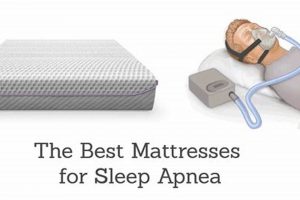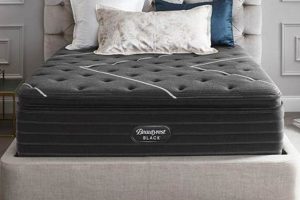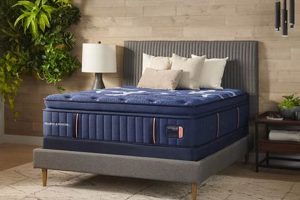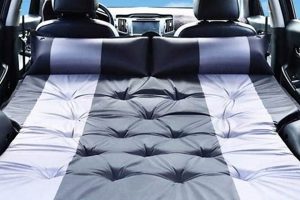Selecting a mattress to accommodate prone sleeping requires careful consideration. The ideal surface provides a balance of support and cushioning, preventing spinal misalignment and promoting restful sleep. For individuals who primarily sleep on their stomachs, a mattress that mitigates excessive sinking in the torso area is crucial for maintaining a neutral spinal posture.
The value of an appropriate sleep surface extends beyond immediate comfort. Consistent spinal alignment during sleep can contribute to reduced back pain, minimized pressure on internal organs, and improved overall sleep quality. Historically, various materials have been employed in mattress construction; however, modern advancements allow for tailored support based on individual sleeping positions and body types.
The following sections will delve into specific mattress characteristics, including construction materials, firmness levels, and design features, which contribute to optimal sleep for those who favor the stomach-sleeping position. Further discussion will cover potential drawbacks of unsuitable mattresses and offer guidance on selecting a mattress that addresses individual needs and preferences.
Guidance for Stomach Sleepers
Selecting a mattress that accommodates the stomach-sleeping position requires careful consideration of several key factors. The following recommendations aim to guide individuals towards making informed decisions that promote proper spinal alignment and overall sleep quality.
Tip 1: Prioritize Firmness. A firmer mattress surface helps prevent excessive sinking of the midsection, which can lead to spinal hyperextension. Mattresses rated as firm or extra firm are generally more suitable for stomach sleepers than softer alternatives.
Tip 2: Consider Hybrid or Innerspring Construction. Mattresses utilizing coil-based support systems, often found in hybrid or innerspring models, provide robust support and minimize sagging. These constructions typically offer better long-term durability for stomach sleepers compared to all-foam options.
Tip 3: Evaluate the Comfort Layer. While firmness is essential, a thin comfort layer of memory foam or latex can provide pressure relief without compromising support. Ensure the comfort layer is not excessively thick, as this can counteract the benefits of a firm support core.
Tip 4: Research Zoned Support Systems. Mattresses featuring zoned support offer targeted reinforcement in specific areas, such as the lumbar region. This can further enhance spinal alignment and reduce pressure points for stomach sleepers.
Tip 5: Assess Edge Support. Strong edge support prevents the edges of the mattress from collapsing under pressure. This is particularly important for stomach sleepers who tend to utilize the entire sleep surface.
Tip 6: Trial Period Utilization. Whenever possible, take advantage of mattress trial periods to assess the suitability of a particular model. Spending several weeks sleeping on a mattress is the most effective way to determine its long-term comfort and support.
Tip 7: Investigate Material Breathability. Stomach sleeping can trap body heat against the mattress surface. Consider mattresses constructed with breathable materials, such as open-cell foam or natural latex, to promote airflow and temperature regulation.
These guidelines highlight the importance of firmness, support system, and material selection in choosing a mattress to accommodate the stomach-sleeping position. Proper alignment minimizes discomfort and promotes restful sleep.
The subsequent sections will explore common misconceptions surrounding mattresses and offer practical advice for maintaining a healthy sleep environment.
1. Firmness Level
The firmness level of a mattress is a primary determinant of its suitability for stomach sleepers. It dictates the degree to which the sleeper’s body sinks into the mattress surface. Insufficient firmness leads to excessive compression of the abdomen and a pronounced curvature of the spine, resulting in discomfort and potential long-term orthopedic issues. For instance, a stomach sleeper on a plush mattress may experience lower back pain due to the unnatural spinal alignment. Conversely, appropriate firmness provides a stable, supportive surface that helps maintain a more neutral spinal position throughout the night. This effect is crucial for minimizing strain on the musculoskeletal system and facilitating restorative sleep.
Selecting an appropriate firmness level requires consideration of individual body weight and build. A heavier individual will generally require a firmer mattress to achieve the same level of support as a lighter person. Mattresses are typically rated on a scale of 1 to 10, with 1 being the softest and 10 being the firmest. Most stomach sleepers find mattresses in the 6 to 8 range to be optimal. However, a practical approach involves in-store testing or leveraging trial periods offered by manufacturers. This allows for a firsthand assessment of the mattress’s performance and its ability to provide adequate support without sacrificing comfort. Incorrect firmness selection negates the benefits of advanced materials or construction techniques.
In conclusion, the firmness level is a critical component of the mattress selection process for stomach sleepers. Ignoring this factor can negate the advantages of other features, leading to compromised sleep quality and potential health complications. The correlation between proper firmness and spinal alignment underscores the necessity of careful evaluation and informed decision-making. This fundamental understanding bridges the gap between mattress specifications and tangible benefits for the end-user, ensuring a sleep experience conducive to physical well-being.
2. Support Core
The support core of a mattress is paramount in determining its suitability for stomach sleepers. It dictates the overall stability and load-bearing capacity, directly influencing spinal alignment and pressure distribution. The core’s construction and materials are therefore critical considerations.
- Coil Systems: Innerspring and Pocketed Coils
Innerspring cores, with interconnected coils, provide a traditional and resilient support system. Pocketed coil systems, where each coil is individually wrapped, offer enhanced contouring and motion isolation. For stomach sleepers, a firmer innerspring or a pocketed coil system with a higher coil gauge can prevent excessive sinking in the midsection, maintaining spinal alignment and reducing pressure on the lower back. The coil count and arrangement influence the mattress’s ability to uniformly distribute weight.
- High-Density Foam: Polyfoam and Latex
High-density polyfoam and latex cores offer alternative support st
ructures. High-density polyfoam provides a firm, cost-effective base. Latex, available in Dunlop and Talalay varieties, offers a more responsive and durable option. Stomach sleepers benefit from high-density foam cores that resist compression and maintain a level sleeping surface. The density of the foam is a key indicator of its long-term performance; higher densities translate to improved resistance to body impressions and sagging. - Hybrid Construction: Combining Coils and Foam
Hybrid mattresses integrate coil systems with foam layers, seeking to combine the benefits of both. This construction allows for targeted support and pressure relief. For stomach sleepers, a hybrid mattress with a firm coil core and a thinner layer of high-density foam or latex can provide both the necessary support to prevent spinal misalignment and a degree of comfort for pressure points. The layering and density of the foam components within the hybrid significantly affect its overall performance.
- Edge Support Systems: Reinforced Borders
Edge support systems, often incorporating firmer coils or foam encasements around the mattress perimeter, enhance the usable sleep surface and prevent edge collapse. For stomach sleepers who tend to sleep near the edge of the bed, reinforced edges provide crucial stability and prevent a feeling of roll-off. Adequate edge support contributes to the overall structural integrity of the mattress and ensures consistent support across the entire surface.
In conclusion, the support core’s composition and design directly influence a mattress’s capacity to accommodate the specific needs of stomach sleepers. A robust and appropriately firm support core, whether coil-based or foam-based, is essential for maintaining proper spinal alignment and preventing discomfort. The choice of core material and construction must align with individual preferences and body weight to achieve optimal sleep quality.
3. Surface Material
The outermost layer of a mattress, or the surface material, directly influences comfort, temperature regulation, and the overall sleeping experience, particularly for those who favor the stomach-sleeping position. The selection of surface material affects pressure distribution and airflow, both of which play a pivotal role in sleep quality. The impact is evident in instances where an unsuitable surface material leads to overheating or uneven support, thus disrupting sleep patterns. The consideration of surface material is a fundamental aspect of identifying the best type of mattress because it mediates the interaction between the sleeper and the support core. This interface dictates how effectively the sleeper’s weight is distributed and how effectively the mattress adapts to the sleeper’s body contours.
Various materials are commonly employed as mattress surfaces, each possessing distinct characteristics. Traditional cotton offers breathability and a soft feel, but may lack durability. Memory foam conforms closely to the body, providing pressure relief but potentially trapping heat. Latex offers a balance of support and responsiveness, with natural variations providing enhanced breathability. More advanced materials, such as phase-change materials (PCMs), are designed to regulate temperature by absorbing and releasing heat as needed. The practical application of selecting a surface material is highlighted when a stomach sleeper, prone to overheating, chooses a mattress with a PCM-infused cover. This material helps maintain a consistent temperature, reducing discomfort and promoting uninterrupted sleep. Similarly, a stomach sleeper with sensitive skin might benefit from a hypoallergenic organic cotton cover.
In summary, the surface material of a mattress contributes significantly to the sleeping experience, particularly for stomach sleepers. Choosing the optimal surface material, carefully considering factors such as breathability, pressure relief, and durability, is crucial for maximizing comfort and promoting restorative sleep. While challenges remain in evaluating the long-term performance of novel materials, prioritizing surface material selection enables informed decisions. It ultimately links the material characteristics to broader themes of sleep health and well-being.
4. Edge Support
Edge support, a crucial aspect of mattress design, significantly influences the sleeping experience, particularly for stomach sleepers. This feature refers to the reinforcement along the perimeter of a mattress, preventing compression and maintaining a consistent sleeping surface. The correlation between robust edge support and comfort for stomach sleepers arises from the tendency of individuals in this position to utilize the entire mattress surface, often sleeping near the edges. Weak edge support can lead to a feeling of instability and an increased risk of rolling off the bed, disrupting sleep and potentially causing injury. For instance, a stomach sleeper sharing a bed with a partner may inadvertently move closer to the edge, and without adequate support, experience discomfort and interrupted sleep.
The design of edge support systems varies, encompassing features such as reinforced coils, high-density foam encasements, or steel rod frameworks. These enhancements mitigate edge compression and expand the usable sleeping area. This benefit extends beyond individual comfort; it also influences the long-term durability of the mattress. By preventing edge collapse, the overall structural integrity is maintained, ensuring uniform support and preventing premature sagging. Consider a scenario where a stomach sleeper regularly sits on the edge of the bed to dress; without sufficient edge support, that area of the mattress will degrade more quickly, leading to uneven support and reduced comfort over time.
In summary, edge support represents a critical component of a mattress tailored for stomach sleepers. It directly impacts sleep quality, safety, and the longevity of the mattress itself. While the specific design elements may differ, the underlying principle remains the same: to provide a stable and reliable sleeping surface across the entire mattress. The practical significance of understanding and prioritizing edge support lies in its contribution to a more comfortable, supportive, and durable sleep environment. The implementation translates into long-term value and sleep quality.
5. Breathability
Breathability, referring to a mattress’s capacity to facilitate airflow and dissipate heat, is a significant factor influencing the sleep quality of stomach sleepers. The prone position often results in greater body surface contact with the mattress, potentially leading to increased heat retention and discomfort. Therefore, the breathability of the sleep surface directly affects the sleeping environment.
- Material Composition
The materials used in mattress construction significantly impact breathability. Open-cell foams, such as certain types of latex and some advanced memory foams, allow for greater airflow compared to denser, closed-cell materials. Natural fibers like cotton and wool, often used in mattress covers, also contribute to breathability. The choice of materials should consider their innate ability to dissipate h
eat and moisture, thereby preventing the buildup of a warm, humid microclimate around the sleeper. - Construction Techniques
Beyond the materials themselves, construction methods influence airflow within the mattress. For example, mattresses with convoluted foam layers or strategically placed ventilation channels can enhance air circulation. The spacing and arrangement of coils in innerspring or hybrid mattresses also play a role, allowing for greater airflow compared to solid foam cores. These design features are critical for promoting a cooler and more comfortable sleep environment, especially for stomach sleepers.
- Cover Design
The mattress cover acts as the primary interface between the sleeper and the mattress. Breathable cover materials, such as those woven from natural fibers or incorporating specialized ventilation panels, can significantly improve airflow. Conversely, impermeable or tightly woven covers can restrict airflow, exacerbating heat retention. The cover’s design should prioritize breathability to facilitate the effective transfer of heat and moisture away from the sleeper’s body.
- Environmental Factors
Ambient room temperature and humidity levels also interact with mattress breathability to influence the sleeping experience. In warmer climates or during summer months, a highly breathable mattress becomes even more critical for maintaining a comfortable sleep environment. The ability of a mattress to dissipate heat is directly related to the surrounding environmental conditions, and these factors should be considered when selecting a mattress for stomach sleepers in different geographic locations or seasons.
Considering these facets collectively, breathability emerges as a key attribute in determining the suitability of a mattress for stomach sleepers. The combination of breathable materials, thoughtful construction techniques, and appropriate cover design can significantly enhance sleep quality by minimizing heat retention and promoting a cooler, more comfortable sleeping environment. The absence of breathability compromises the ability to rest.
6. Zoned Support
Zoned support represents a strategic design element in mattress construction, particularly relevant when considering optimal sleep surfaces for stomach sleepers. This feature involves varying the firmness or support levels across different areas of the mattress to accommodate the body’s natural curves and pressure points. Its significance lies in its ability to promote spinal alignment and alleviate discomfort specific to the stomach-sleeping position.
- Lumbar Reinforcement
The lumbar region, or lower back, often requires additional support to prevent excessive sinking when sleeping on the stomach. Zoned support systems typically incorporate firmer materials or enhanced coil configurations in this area to maintain spinal alignment and reduce the risk of lower back pain. For example, a mattress designed with a denser foam core or a higher coil count in the lumbar zone can provide targeted reinforcement, preventing the spine from arching unnaturally and minimizing strain on the surrounding muscles. This targeted support distinguishes zoned mattresses from those with uniform firmness throughout, making them a potentially valuable asset for stomach sleepers prone to back issues.
- Shoulder and Hip Accommodation
While the lumbar region benefits from increased support, the shoulder and hip areas may require a slightly softer feel to accommodate their broader contours. Zoned support systems can incorporate softer materials or strategically placed pressure-relief zones in these areas to prevent excessive pressure buildup and promote comfortable spinal alignment. For example, a mattress might feature a layer of softer memory foam or latex in the shoulder and hip zones to allow these areas to sink in slightly, while still maintaining overall support. This differential firmness distribution is crucial for preventing pressure points and ensuring a more balanced sleep experience.
- Spinal Alignment Optimization
The primary goal of zoned support is to optimize spinal alignment, regardless of sleeping position. For stomach sleepers, this requires preventing excessive curvature of the spine and maintaining a relatively neutral posture. Zoned support systems achieve this by providing targeted support and pressure relief in specific areas, ensuring that the spine is properly aligned from head to toe. Without zoned support, a stomach sleeper may experience spinal misalignment, leading to discomfort, pain, and potential long-term health issues. The ability of a mattress to adapt to the individual’s unique body shape and sleeping position is therefore a critical factor in determining its suitability.
- Material and Construction Variations
Zoned support can be implemented using various materials and construction techniques. Some mattresses utilize different densities of foam in different zones, while others employ varying coil gauges or configurations. Hybrid mattresses, which combine foam and coil systems, often incorporate zoned support features to leverage the strengths of both materials. The effectiveness of a zoned support system depends on the specific materials used, the design of the zones, and the overall construction of the mattress. For example, a mattress with a combination of high-density foam and strategically placed pocketed coils may offer superior zoned support compared to a mattress with a uniform foam core.
In conclusion, zoned support contributes significantly to the overall suitability of a mattress for stomach sleepers by addressing their specific support and pressure-relief needs. By strategically varying firmness levels across different areas of the mattress, zoned support systems promote spinal alignment, alleviate discomfort, and enhance sleep quality. While individual preferences and body types may vary, the incorporation of zoned support represents a valuable feature to explore when seeking the optimal sleep surface for this position.
Frequently Asked Questions Regarding Mattress Selection for Prone Sleepers
This section addresses common inquiries and misconceptions concerning mattresses tailored to individuals who primarily sleep on their stomachs. The information provided aims to clarify key considerations and guide informed decision-making.
Question 1: What firmness level is generally recommended?
A medium-firm to firm mattress is typically advised. This firmness range helps prevent excessive sinking of the midsection, maintaining spinal alignment and reducing lower back strain. Individual preferences and body weight should also be considered.
Question 2: Are memory foam mattresses suitable?
While memory foam offers pressure relief, an all-memory foam mattress may not provide adequate support for stomach sleepers. Hybrid mattresses, combining a coil support core with a memory foam comfort layer, can be a more suitable option, provided the overall firmness is appropriate.
Question 3: How important is edge support?
Strong edge support is beneficial. It maximizes the usable sleep surface and prevents a feeling of rolling off the bed, particularly important for those who tend to sleep near the edge of the mattress.
Question 4: Can mattress covers impact sleep quality?
Yes. Breathable mattress covers, made from materials like cotton or bamboo, promote airflow and reduce heat retention, con
tributing to a more comfortable sleep environment.
Question 5: What role does body weight play in mattress selection?
Body weight significantly influences the required firmness level. Heavier individuals generally need a firmer mattress to prevent excessive sinking, while lighter individuals may find a medium-firm mattress more comfortable.
Question 6: Should existing back pain influence mattress choice?
Yes. Individuals with pre-existing back pain should consult with a healthcare professional or physical therapist for personalized recommendations. A mattress that provides adequate support and promotes proper spinal alignment is crucial for managing back pain.
In summary, selecting a mattress for prone sleeping requires careful consideration of firmness, support, materials, and individual needs. The information presented here serves as a foundation for making informed decisions and optimizing sleep quality.
The following section will explore strategies for maintaining a healthy sleep environment, complementing the benefits of a well-chosen mattress.
In Summary
This exploration of the factors defining a suitable sleep surface for prone sleepers underscores the necessity of a multi-faceted approach. Prioritization of firmness, support core integrity, surface material breathability, and edge support constitutes the framework for informed decision-making. Integration of zoned support systems further enhances the potential for spinal alignment. Therefore, a comprehensive understanding of these elements allows for optimal selection.
Investing in a mattress aligned with the specific needs of stomach sleeping represents a commitment to long-term spinal health and restorative sleep. The principles outlined herein provide a foundation for navigating the complexities of the mattress market and ultimately enhancing overall well-being. Continued awareness and informed choices contribute to a healthier sleep environment and an improved quality of life.





![Top-Rated Best Daybed Mattress [2024]: Buyer's Guide Organic & Natural Mattress Buyer’s Guide: Non-Toxic Sleep Solutions Top-Rated Best Daybed Mattress [2024]: Buyer's Guide | Organic & Natural Mattress Buyer’s Guide: Non-Toxic Sleep Solutions](https://mattressworldpa.com/wp-content/uploads/2025/07/th-7669-300x200.jpg)

